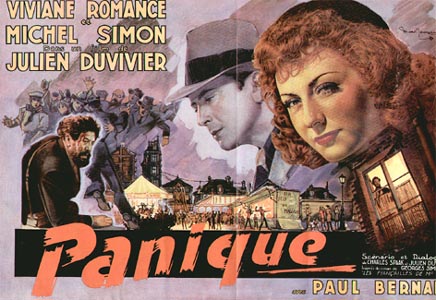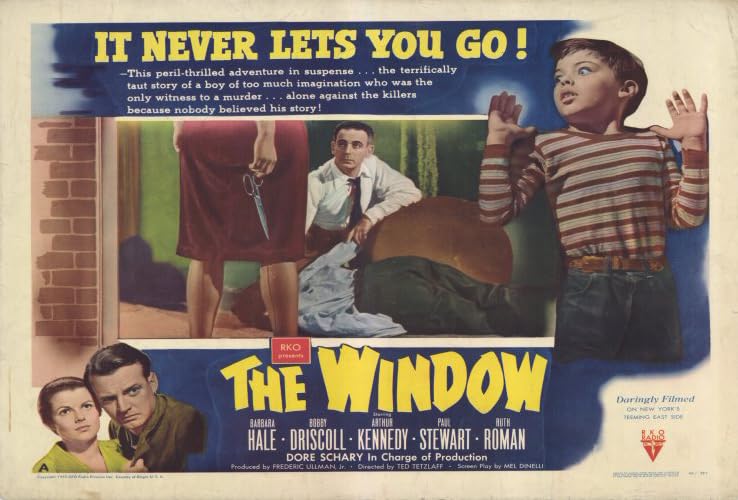I watched a couple of pretty good new-to-me movies that could loosely be described as noir: Panique (1946) and The Window (1949). Both of them are based on fiction I haven’t read, but now kind of want to. Reviews follow, along with some spoilers. But neither of these movies is a mystery in the whodunit sense.
In Panique, a guy who goes by three names, but is usually called Monsieur Hire (Michel Simon) falls under suspicion of having murdered a woman. The infallible signs that point to his guilt are: he’s always taking pictures of things, he’s Jewish, and people don’t like him. He’s quite aware of his universal unpopularity; at one point, he remarks that even his mom didn’t like him much.
In fact, he didn’t commit the murder, but he knows who the killer is, an auto-mechanic calling himself Alfred (Paul Bernard). When Hire sees a young woman named Alice (Viviane Romance) getting friendly toward Alfred, he tries to warn her off. When Alice asks Hire how he can be sure Alfred is the murderer, he tells her that he saw it happen while he was taking a slash in the vacant lot. When she asks him why he doesn’t tell the police, he laughs and says it’s against his philosophy.
Unfortunately for Hire, Alice is Alfred’s longtime girlfriend. They’re just pretending to meet for the first time, as he’s a career criminal on the run and she’s an ex-con who just got out of prison for a robbery he committed. Alfred and Alice manipulate feeling in the neighborhood against Monsieur Hire. Hire takes an interest in Alice, and she convinces him she likes him, primarily so that she can plant some evidence on him (the murdered woman’s purse).
In the climactic scene, the neighborhood forms a mob that attacks Monsieur Hire. He flees from them and the police, losing his camera in the process. He falls to his death, and Alice and Alfred figure that’s the end of it.
But it’s not. Hire was always taking photos of weird, ugly things, and one of the weird, ugly things he took a photo of was the murder. The police find the photo and they’re closing in on Alice and Alfred at the movie’s end.
Michel Simon gave a very likable performance of an unliked man. He has his principles and abides by them, and he carries the irrational hate of his neighbors on his shoulders without bending under the weight.
Viviane Romance apparently had a long career of playing femmes fatales in French movies. She renders Alice with weary charm; you can see why Monsieur Hire is taken with her, and you can fully understand why she prefers the loathsome Alfred.
Paul Bernard’s performance of Alfred was a little odd. He may have been a little old for the role of a youngish criminal. His face seemed very heavily made up, and he wore a lot of scarves and tweedy clothing you wouldn’t expect a mechanic to be wearing at work.
This movie marked the director’s return to French cinema after a wartime exile to the United States. It can be read as a commentary on the French who collaborated with the Nazis in WWII. The citizens who turn so readily on an innocent man are repugnant, as are the criminals who edge them on.
But Monsieur Hire shares some responsibility for the fatal predicament he finds himself in. If he’d been civic-minded enough to go to the police with what he knew, he might have lived peacefully and unpopularly ever after. On the other hand, what does a man owe to a community that hates him for no good reason?
The movie is based on a novella by George Simenon, Les Fiançailles de M. Hire (Monsieur Hire’s Engagement). I’m not a huge fan of Simenon, having bounced off a couple of different Inspector Maigret novels. But this book sounds like it might be worth checking out.
Okay, since it’s just you and me here in the absolute privacy of my blog, where no one ever comes, I’ll admit something. I watched The Window because Barbara Hale has the top billing. I always liked her in Perry Mason, where she played the unflappable Della Street, and I thought it would be fun to see her play the lead in something.
Maybe she did sometime, but this isn’t it. The main character in this movie is the kid, Tommy (Bobby Driscoll) who witnesses a murder. Nearly as important are the murderous upstairs neighbors, the Kellersons (a dead-eyed and terrifying Paul Stewart and a semi-ruthless Ruth Roman). Then there’s the kid’s kindly and frustrated father (Arthur Kennedy). Barbara Hale is Tommy’s mom, a relatively trivial role that anyone wearing a dress could have played as well. I guess she had a great agent; it’s too bad he didn’t get her a better part, though.
Tommy’s original problem is this: he’s a damn liar. He’s always making up some ridiculous story to get people to notice him, and it’s driving his parents crazy. One fiercely hot summer night, he sleeps out on the fire escape outside the family’s apartment. From that vantage point, he watches in horror as the couple upstairs rob and murder a man they’ve lured somehow into their apartment.
He tells everybody he can get to listen to him, but of course almost no one believes him. He’s the boy who’s cried “Wolf!” once too often.
There are two people who believe his stories of apartment-house murder, though: the murderers. Once they realize that their crime has been witnessed, they set out to silence the neighborhood storyteller once and for all.
The movie has a slow but not uninteresting start, carefully establishing Tommy’s fraught relationship with the neighborhood and with his frazzled parents. The pace picks up with the murder, as you might expect. The climactic sequence, which finds Tommy fleeing from the murderers in the empty hours of the night, through dark streets and abandoned buildings, is pretty harrowing.
The story that the film was based on is “Fire Escape” (a.k.a. “The Boy Who Cried Murder”) by William Irish (a.k.a. Cornell Woolrich). Woolrich has his fans, but I’ve never really been one of them. I did like The Bride Wore Black, though, and I’ve liked other movies based on his short fiction (e.g. the classic Rear Window). Now I’m thinking I should give his short stories a try.


